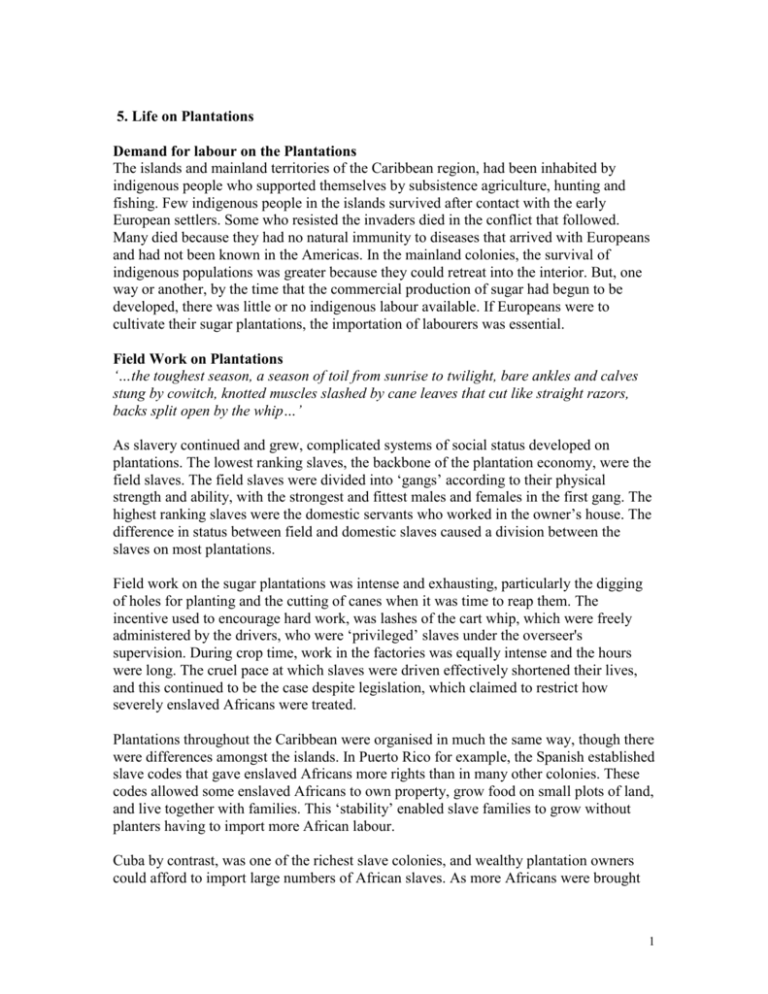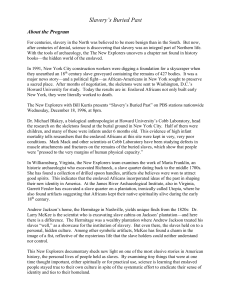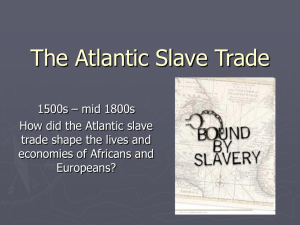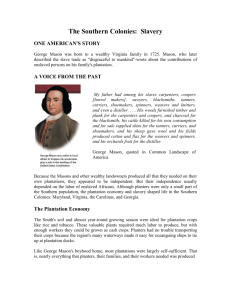LIFE ON THE PLANTATIONS - Anti
advertisement

5. Life on Plantations Demand for labour on the Plantations The islands and mainland territories of the Caribbean region, had been inhabited by indigenous people who supported themselves by subsistence agriculture, hunting and fishing. Few indigenous people in the islands survived after contact with the early European settlers. Some who resisted the invaders died in the conflict that followed. Many died because they had no natural immunity to diseases that arrived with Europeans and had not been known in the Americas. In the mainland colonies, the survival of indigenous populations was greater because they could retreat into the interior. But, one way or another, by the time that the commercial production of sugar had begun to be developed, there was little or no indigenous labour available. If Europeans were to cultivate their sugar plantations, the importation of labourers was essential. Field Work on Plantations ‘…the toughest season, a season of toil from sunrise to twilight, bare ankles and calves stung by cowitch, knotted muscles slashed by cane leaves that cut like straight razors, backs split open by the whip…’ As slavery continued and grew, complicated systems of social status developed on plantations. The lowest ranking slaves, the backbone of the plantation economy, were the field slaves. The field slaves were divided into ‘gangs’ according to their physical strength and ability, with the strongest and fittest males and females in the first gang. The highest ranking slaves were the domestic servants who worked in the owner’s house. The difference in status between field and domestic slaves caused a division between the slaves on most plantations. Field work on the sugar plantations was intense and exhausting, particularly the digging of holes for planting and the cutting of canes when it was time to reap them. The incentive used to encourage hard work, was lashes of the cart whip, which were freely administered by the drivers, who were ‘privileged’ slaves under the overseer's supervision. During crop time, work in the factories was equally intense and the hours were long. The cruel pace at which slaves were driven effectively shortened their lives, and this continued to be the case despite legislation, which claimed to restrict how severely enslaved Africans were treated. Plantations throughout the Caribbean were organised in much the same way, though there were differences amongst the islands. In Puerto Rico for example, the Spanish established slave codes that gave enslaved Africans more rights than in many other colonies. These codes allowed some enslaved Africans to own property, grow food on small plots of land, and live together with families. This ‘stability’ enabled slave families to grow without planters having to import more African labour. Cuba by contrast, was one of the richest slave colonies, and wealthy plantation owners could afford to import large numbers of African slaves. As more Africans were brought 1 to the island, the Spanish army was kept there to defend the Cuban Creoles and whites against the possibility of a slave revolt. During the mid 1800’s the many mulattos and mestizos in Cuba enjoyed better lives and were generally wealthier than the field slaves. In Barbados women did most of the field labour, while men did more skilled work. Enslaved Africans suffered some of the harshest conditions in Barbados during the sugar boom where, unlike Puerto Rico, slave families were not allowed to live together. Life on North American Plantations Solomon Northrop, a former enslaved African, described life on the cotton fields in Louisiana: ‘there is no such thing as rest, the hands are required to be in the cotton fields as soon as it is light in the morning, and with the exception of ten or fifteen minutes, which is given for break, they are not permitted to be a moment idle until it is dark to see’. The work of the enslaved was organised depending on the crop being cultivated. In Virginia and Maryland where the main crop was tobacco, enslaved Africans worked in small to medium-sized fields. Planters, who owned hundreds of slaves, often divided them among several plantations. Masters and slaves lived close to each other, so the owner could watch over and control ‘his’ slaves. In South Carolina and Georgia the main crop was rice. Because rice required irrigation and a large co-ordinated labour force, enslaved people lived and worked in larger groups. Plantation owners lived in towns and employed white overseers to manage their estates. While life on plantations varied significantly in different regions, slave codes in every state deprived African Americans of their basic human rights and gave slave masters the power to control them ruthlessly. However, despite the exploitation and oppression of the plantation system, narratives of enslaved Africans speak of their continuous search for freedom. Whether through small or larger scale resistance, Africans always rebelled against their enslavement. Resistance and Revolt The inhuman, harsh and intolerable conditions on these plantations led to rebellion and revolt. The laws and punishments of the 1733 ‘Slave Codes’ in the Caribbean were some of the most severe ever known, and were for example, the main cause of the St. John Revolt (1733-34). The newly arrived ‘Animas’ or ‘Minas’ (as the slaves were then called) from Africa refused to accept the horrifying conditions of slavery and life on the plantations. Most of these revolts ended in failure, and slave owners revenge was immediate and brutal. Enslaved ‘rebels’ were put to death on the spot, and many committed suicide rather than suffer such unspeakable brutality. Despite the horrific conditions that millions were forced to endure, they were able to create ways of coping with their situations that gave expression to their humanity, and maintained their African heritage and identity. 2 Impact of Plantation Life on Children Plantation life had an enormously dramatic impact on enslaved Africans in the Caribbean, Americas and North America. A historian talking about the effect on children born into slavery said: ‘This generation won’t know Africa in the same way that their parents knew Africa.... The child also won’t know freedom in the same way that a parent knew freedom... Because a child sees daily the whippings, the brutality of the system, sees their parents coming under the authority, coming under the rule of the whip of the overseer, even. So it’s very difficult. But at the same time, I think parents teach children what it is to be about the slave community. And that’s family. That’s religion. And that’s togetherness’. 3









